SEARCH
Indian City Heritage: Your Guide to UNESCO Sites and Historic Gems
India is a patchwork of old streets, stone forts, and vibrant markets that tell stories older than most countries. If you love wandering through places where every alley has a tale, you’re in the right spot. This guide shows you why city heritage matters, which cities top the list, and how to make the most of each visit without getting lost or broke.
Why India's Heritage Cities Matter
Heritage cities are living museums. They preserve architecture, art, and customs that survived centuries of change. Walking through a UNESCO‑listed city like Jaipur or Varanasi feels like stepping into a textbook, only the pages breathe, smell, and sound. These cities also boost local economies—tourists spend on food, crafts, and stay, which helps artisans keep their traditions alive.
Top Heritage Cities to Visit
Delhi, Agra, and Jaipur – The Golden Triangle – This trio is the classic entry point for most travelers. Delhi’s bustling lanes hide Mughal monuments; Agra’s Taj Mahal is an icon of love; Jaipur’s pink walls showcase Rajput grandeur. All three are UNESCO‑linked and have easy transport links, making them perfect for a 5‑day loop.
Varanasi – The spiritual heart of India. Its ghats line the Ganges, and sunrise boat rides reveal rituals you won’t see anywhere else. The city’s ancient temples and narrow lanes are a photographer’s dream.
Mysore – Known for its royal palace, silk, and sandalwood. The city’s well‑preserved market squares and annual Dasara festival give a true taste of Karnataka’s heritage.
Hampi – A UNESCO World Heritage Site that feels like an open‑air ruin park. Massive stone blocks, broken arches, and the iconic “Stone Chariot” make every step feel cinematic.
Khajuraho – Famous for its erotic temples, the intricate carvings are both artistic marvels and historical records of ancient life.
Each city offers a mix of free attractions (temples, markets) and ticketed sites (palaces, museums). To stretch your budget, start your day at a free spot, grab a local breakfast of poha or idli, then head to the paid landmarks during off‑peak hours.
When you plan, check the best travel season for each city. For most heritage spots, October to March brings comfortable weather. Monsoon rains can make some streets slippery, but they also add a dramatic backdrop to forts and rivers.
Finally, respect local customs. Dress modestly at religious sites, remove shoes where asked, and ask before photographing people. Small gestures go a long way in earning smiles and inside tips from locals.

Which City of India is Known as a World Heritage Site?
Explore the world-renowned heritage city of India, known for its rich history and cultural significance. Discover what makes this city a UNESCO World Heritage site and delve into its unique attractions. Learn interesting facts and tips to make the most of your visit. Understand the historical significance and the best spots to explore in this iconic city.
Continue reading